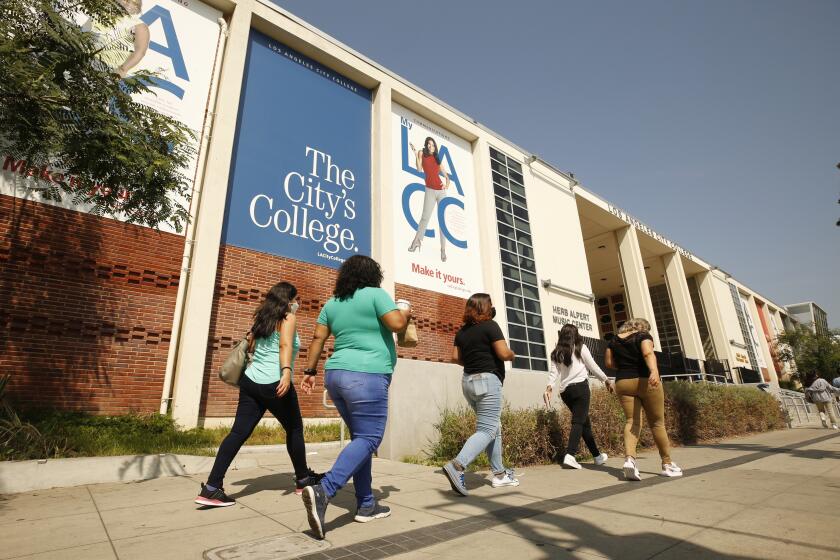Fake students enrolled in community colleges. One bot-sleuthing professor fights back

- Share via
At 1 in the morning, insomnia struck again.
So the criminal justice professor settled into the family room couch and opened her laptop to try to root out suspected crime right before her eyes: fake student bots.
Since learning several months ago that an unknown number of fraudulent students registered in classes throughout California’s community college system, Kim Rich, a Pierce College professor and department chair, has taken it upon herself to become a bot sleuth. After combing through her and other professors’ class rosters she suspects the problem has not gone away.
She has alerted her administrators that she thinks the bots could even be multiplying, and she and other faculty members said they have grown frustrated at the pace of the broader investigation. Officials are mum about it at Pierce College and throughout the community college system and declined to release information about their ongoing probe into the possibility of widespread fraud, possibly linked to obtaining financial aid.
“This is something you can’t wait on,” Rich said. “If someone is committing financial aid fraud, that is taxpayer money.”
California officials and community college staff have uncovered what is believed to be one of the state’s largest college financial aid scam attempts.
The California Community Colleges Chancellor’s Office estimated over the summer that 20% of recent traffic on its main portal for online applications was “malicious and bot-related” and was thought to be tied to financial aid fraud. More than 60,000 suspected fake students applied for financial aid, the California Student Aid Commission told The Times in September. At least hundreds of thousands of dollars in financial aid has been distributed to bots, according to interviews and early reports from with officials at six colleges.
But the scope of the situation is unclear. The state has asked each college to prepare monthly reports on the number of incidents of suspected and confirmed registration fraud, confirmed number of incidents of financial aid fraud, and its dollar value. It also announced that it would be using a new software to help prevent bot registration. But officials have declined to release the reports on the grounds that the information is involved in a fraud investigation.
That’s why Rich remains undeterred in her anti-bot crusade, intent on spreading the word to other professors to be on the lookout.
She has learned how to identify patterns of bots and has shared her findings with Pierce College colleagues, disturbed that potential fake students have taken slots away from real students and could be wasting taxpayer dollars.
She can’t explain exactly what it is that tips her off to a potential bot — “it’s just something that catches my eye.”
She scours class rosters looking for odd patterns in names or a string of characters in place of a name; students’ avatars used in the system to upload assignments that look different than the norm. With research and photo searches, she’s connected some of those images to a dead person, an author, a professor up north and an East Coast attorney — people she suspects could be victims of identity theft. Recently, she’s mined names attached to new student ID numbers and found spellings similar to Donald Trump and Barack Obama.
California’s overall 6.5% drop in undergraduate enrollment is higher than the national average and the sixth highest in the nation.
Before she started teaching in 2008 at Pierce College, Rich had a law enforcement background, working with detectives at the sheriff’s office on cases involving identity theft and burglaries — skills that primed her for the task at hand. At Pierce she has risen to chair of Political Sciences, Economics and Criminal Justice.
Rich, who has always taught online classes, first noticed suspicious activity over the summer when a handful of students submitted identical assignments. When she realized that the students were registered for the same classes, she suspected it reached beyond plagiarism. The patterns she identified — such as nonsensical answers to introductory prompts and jumbled spellings of common names — were similar to what professors at other colleges said they noticed over the summer before the Chancellor’s Office issued its memo.
In October, she detected a potential new surge connected to late-start classes after she increased enrollment capacity for a faculty member’s class to accommodate people on the waiting list. Within 48 hours, the class filled again — an unusually fast amount of time for a class to fill up, Rich said, even with students waiting for a slot.
“That’s completely unheard of,” Rich said. She began looking through other class rosters and saw an unusual number of the same names registered in the same classes. “That many students taking that many of the same classes with the same teacher at the same time was extremely unusual.”
She suspects bots have also infiltrated winter class sessions, which will start in January. And with the opening of spring session enrollment, she fears there may be no end in sight.
After sharing her finding with Pierce administration, Rich, who has previously given talks to faculty on academic dishonesty, was asked to present her bot observations. After hearing Rich’s concerns, Vice President of Academic Affairs Donna-Mae Villanueva emailed late-start professors and suggested they require interactive engagement from students during the first week of classes to determine if they’re real or fake.
Villanueva said it’s a delicate issue to vet out a fake student while not violating a real person’s privacy. She told professors in an email that if they do not hear from an inactive student within 24 hours to drop them, and to include a syllabus statement informing students that they will be dropped if inactive.
But bots can be tricky to spot and are not always inactive. Reports of suspected bots’ odd written answers to professors’ questions have been common at colleges throughout the state.
In an emailed statement, the Los Angeles Community College District said that the nine-college system and Pierce College officials are aware of Rich’s concerns and continue to address enrollment issues and review class registration.
“Due to pending reviews, as well as for security reasons and the protection of personal information, the District is not releasing specific details at this time about the situation,” LACCD spokesperson William Boyer said. “All concerns raised by faculty are reviewed and responded to as quickly as possible.”
Rich and other faculty said Pierce College administrators contacted her in October to learn about her findings, but have not followed up.
Another professor at Pierce, who wished to remain anonymous, expressed disappointment in the lack of urgency and direction from the college and the district to educate faculty about the fraudulent activity — responsibilities they said should not fall to faculty.
“I understand this might be a difficult thing to solve, but this is a big job. You’re either committing fraud on financial aid offices or you’re committing fraud against the state of California and upping your enrollment numbers.”
The issue also poses potential privacy concerns among students, one professor said.
“We have no guarantee that the people showing up in our online classes are authentic students,” said Curt Duffy, the Los Angeles College Guild’s grievance officer for Pierce College. “How do we know the person in that online discussion forum is not there just to eavesdrop on students’ conversations in discussions that are sometimes personal?”
“As faculty, we feel that there isn’t due diligence with our administration, particularly with admissions and records, to authenticate students,” Duffy said.
Despite her obsession with identifying fake students, Rich acknowledged that she and faculty members “are not cybersecurity experts, we are not enrollment experts. We were hired to educate,” Rich said. “Our job is not to catch these fake students in our classes.”

Bots aren’t an entirely new phenomenon in the college space, as they’ve been connected to scams to help people get discounts using “edu” email addresses, but officials throughout the state agree that this year’s spike is the worst ever. The combination of a decentralized system of 116 community colleges, an increase in federal aid opportunities and an ongoing shift to online activity has created a ripe environment for the newfound bot activity.
The issue has come at an especially critical time as community colleges throughout the state, and nation, have faced a significant drop in enrollment during the pandemic.
Rich’s frustration with the district’s handling of the bot situation played into her decision to submit her resignation as department chair at the end of January.
In an email earlier this month, a Pierce College official touted that the winter 2022 headcount is already at 93% of what it was last winter. Rich was bewildered.
“Great, enrollment is up. But what percentage are fake students?”
More to Read
Sign up for Essential California
The most important California stories and recommendations in your inbox every morning.
You may occasionally receive promotional content from the Los Angeles Times.












